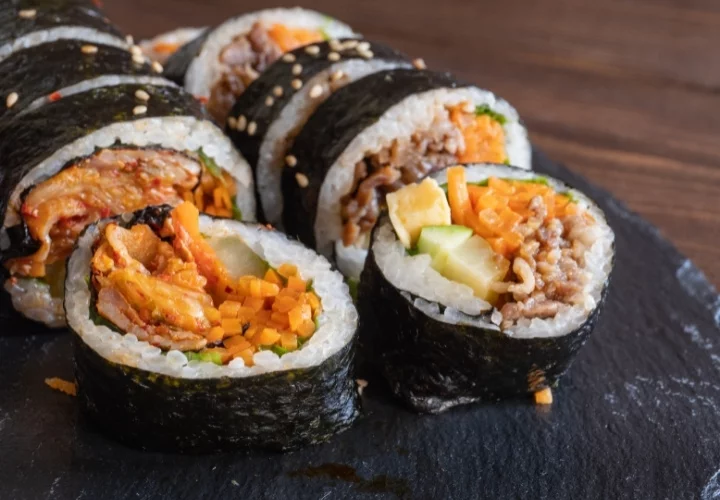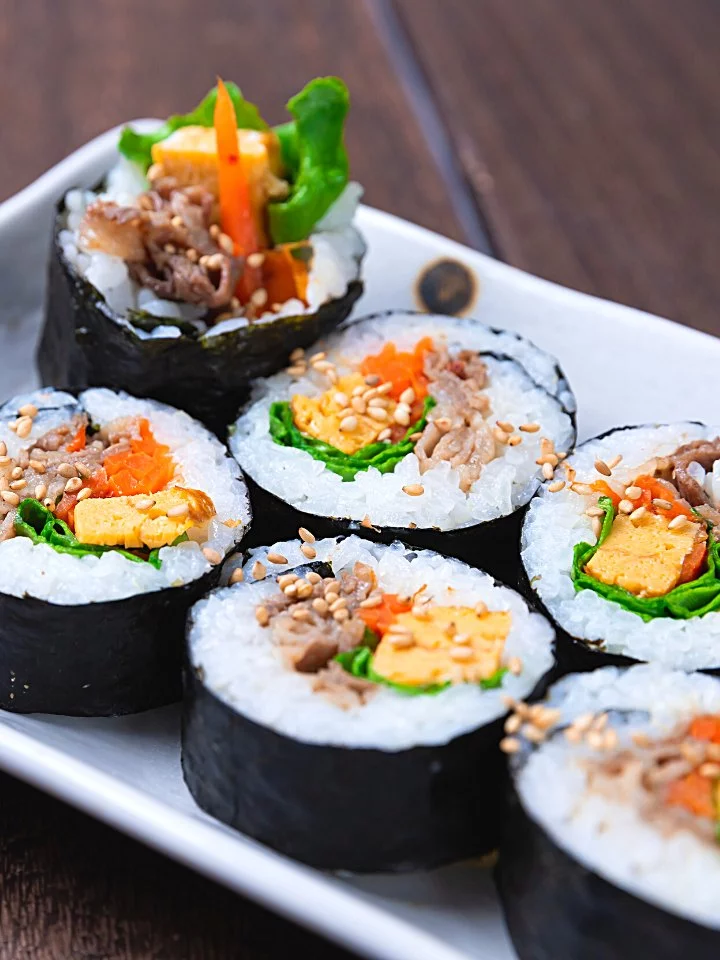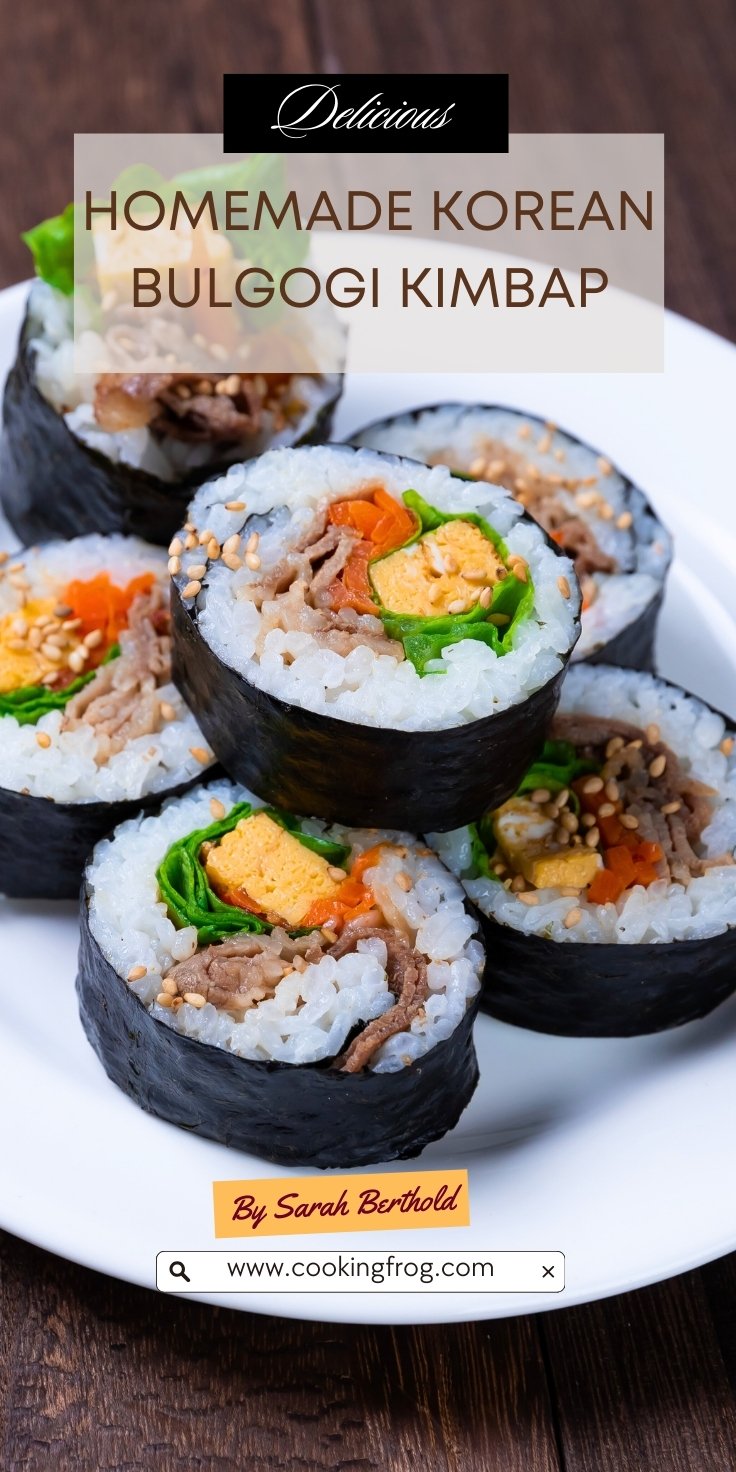Today, I’m going to share with you how to make Beef Bulgogi Kimbap, the Korean version of Japanese “maki,” or rice rolls. This fantastic taste comes from sesame oil and independently seasoned meats and veggies.
What is Bulgogi Kimbap?
Kimbap is a Korean Seaweed Rice Roll that includes seasoned rice And various vegetables and meat that’s rolled in dried seaweed (kim). It’s so delicious and makes for a fantastic snack or lunch!
Though most of the flavor comes from sesame oil and individually seasoned meats and veggies, the one particular ingredient that is the heart of Kimbap is “danmuji,” or bright yellow pickled radish that you could find at the Korean grocery store in the refrigerated section.
Also, everything in the roll is mixed so well that you don’t need to dip it into any type of sauce. Once you have all the ingredients prepped, the building goes by Pretty quickly, and it’s worth it because it’s like having a well-balanced meal in every bite.
Beef Bulgogi Kimbap Recipe
Ingredients:
- Roasted Korean or Sushi Sheets (Seaweed): 7 sheets
- Cooked Short Grain Rice: 5 and 1/2 cups, cooled
- Roasted Sesame Seeds: 1 Tbsp
- Korean Perilla Leaves: 14 leaves, stems removed
- Bulgogi (Korean Marinated Beef): 1 pound, cooked
- Korean Yellow Radish Pickle Strips: 7 strips
- Seasoned Burdock Root Strips: 14 pieces
- English or Lebanese Cucumber: 1, seeds removed, julienned (about 270g/10 ounces)
- Carrot: 1 medium, julienned (about 220g/8 ounces, use a mandoline slicer for best results)
- Sesame Oil: 1 to 2 Tbsp
- Rice Vinegar: 3 Tbsp
- White Sugar: 2 Tbsp
- Kosher Salt: 1-2 tsp
Instructions:
-
Prepare the Rice:
- In a large bowl, mix the cooled steamed rice with rice vinegar, white sugar, and kosher salt. Gently stir in the roasted sesame seeds.
-
Assemble the Kimbap:
- Place a seaweed sheet on a bamboo sushi mat.
- Spread the seasoned rice thinly over the sheet, covering about 90% of the surface.
- In the lower center of the rice layer, arrange the ingredients in the following order: perilla leaves, Bulgogi, yellow radish pickles, seasoned burdock root, cucumber, and carrots.
-
Roll the Kimbap:
- Lift the bottom end of the sushi mat to cover the ingredients.
- Gently roll the seaweed sheet upwards, ensuring the fillings stay in place.
- If the seaweed doesn’t stick, dab a bit of water or place a few rice grains at the edge.
-
Shape and Finish:
- Once rolled, use the bamboo mat to press and shape the roll firmly.
- Repeat the process with the remaining ingredients.
- Finally, brush the rolls with sesame oil for an added nutty flavor and a shiny appearance.
Tips:
- Slicing: Use a sharp knife to slice the rolls. Clean the knife with a wet cloth between cuts to prevent sticking.
- Serving: Serve immediately or wrap in cling film and refrigerate for a short period before serving.
- Variations: Feel free to add or substitute ingredients based on preference, such as avocado, spinach, or tofu.
Love this Beef Bulgogi Kimbap recipe? Share it on your Pinterest board! Inspire your friends, save it for later, and maybe even discover new cooking tips in return. Happy sharing!
Cook’s Tips for Kimbap Recipe
Feel free to add any ingredients you might deem yummy. Some recipes include fish cake, crab, or burdock root.
If you’d prefer to, you can add sesame or julienned perilla leaves instead of spinach, which adds a burst of freshness.
Season all of the individual ingredients well, but don’t go nuts.
The ingredient from which this meal adds the most flavor should be the marinated beef.
The rice should be a tad dull, and everything together needs to be balanced, all in one bite. However, if you have leftovers, just dip the pieces in egg and pan-fry them for a yummy twist.
What is the difference between sushi and kimbap?
They are similar in how they include steamed seaweed and rice. However, sushi rice is seasoned with vinegar, whereas kimbap rice is seasoned with sesame oil. Cut it. Kimbap rice gets dry quickly, so you should eat it the day you make it.




